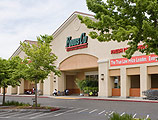“Thus far this year, we’ve dropped three projects because of breathtaking cost estimates.”
A big-time San Francisco contractor told me the other night that he half-wished for another recession. Why? Because his subcontractors—the guys who actually do the work—are so inundated with jobs that they’ve become insufferable: They’re either not answering their phones or they’re handing in stratospheric bids. His subs may indeed be fattening their profit margins, labor may cost a little more, but construction’s real pain is in the skyrocketing price of materials. Another builder said his costs have risen 15-20 percent in the last 12 months, pointing out asphalt’s 50 percent price spike due to the Russian oil fiasco.
As troubling as pricing is the shortage of critical materials. Just one example: Switchgear—the equipment that transforms the raw electricity in power lines to that useable by a project’s tenants—is only manufactured by three companies in America. Two report a 12 month delay in delivery, and the third isn’t taking new orders. Thus, a developer is faced with a Sophie’s Choice: She can either order her switchgear 6 months before she submits her final plans for city approval (and light a candle), or have her project opening delayed up to a year.
Construction cost hikes are nothing new, they’ve persisted since we emerged from the Great Recession. And material shortages have been around since Covid crept out of Wuhan. What’s new is the tarnish on the other side of the coin: real estate’s uncertain values. You can live with cost increases and delays if your profitability is assured, but today, a profit is anything but guaranteed. Where real estate prices will be by yearend is pure speculation. Couple runaway construction costs with interest rates and inflation rising like hot air balloons, and one might conclude that it’s a good time to stop hammering.
I asked one of the Bay Area’s largest residential developers if his company was hitting the pause button on its new developments. “No,” he replied. “Our projects take 5 to 6 years from start-to-finish. So those we’re starting construction on now have the benefit of cheap land we bought years ago. And the brand-new ones won’t come on-line until any recession we may be heading into peters out.”
That may very well work for jillion dollar projects, but for those of us in Double-A ball, that is, with 12-24 month project time horizons, it’s a different story. Here’s one: At the beginning of the year, we had a signed lease with one of our favorite supermarket chains to build a new store. I had blithely assumed it would cost about 25-50 percent more than the last one we’d built for this grocer. Belatedly, we had a reliable contractor price it for us. His number came in 100 percent more than the cost of our last store, the deal no longer penciled out, and we had to tear up the lease.
Thus far this year, we’ve dropped three projects because of breathtaking cost estimates. We sold off one small residential project to a builder more sanguine than ourselves, are in initial discussions to sell or perhaps joint venture another and mothballed a third. On the commercial side, we elected to sell rather than develop a self-storage project. We’re finding that retail—our long-time specialty—only works with fast-food ground leases.
I recently likened our development company to farmers, meaning that we plow ahead with our projects despite the economic monsoons and droughts we inevitably encounter because we trust in business’s long-term favorable climate. True enough, but sticking with that metaphor, there does come a time to rotate crops, to let fields lie fallow. New construction just might be the ground to rest over the next couple years.
Veteran developers will tell you to build in good times (because you can’t find decently priced existing properties) and buy finished buildings when, like today, they’re so often cheaper than replacement cost. Not a bad rule of thumb.






















